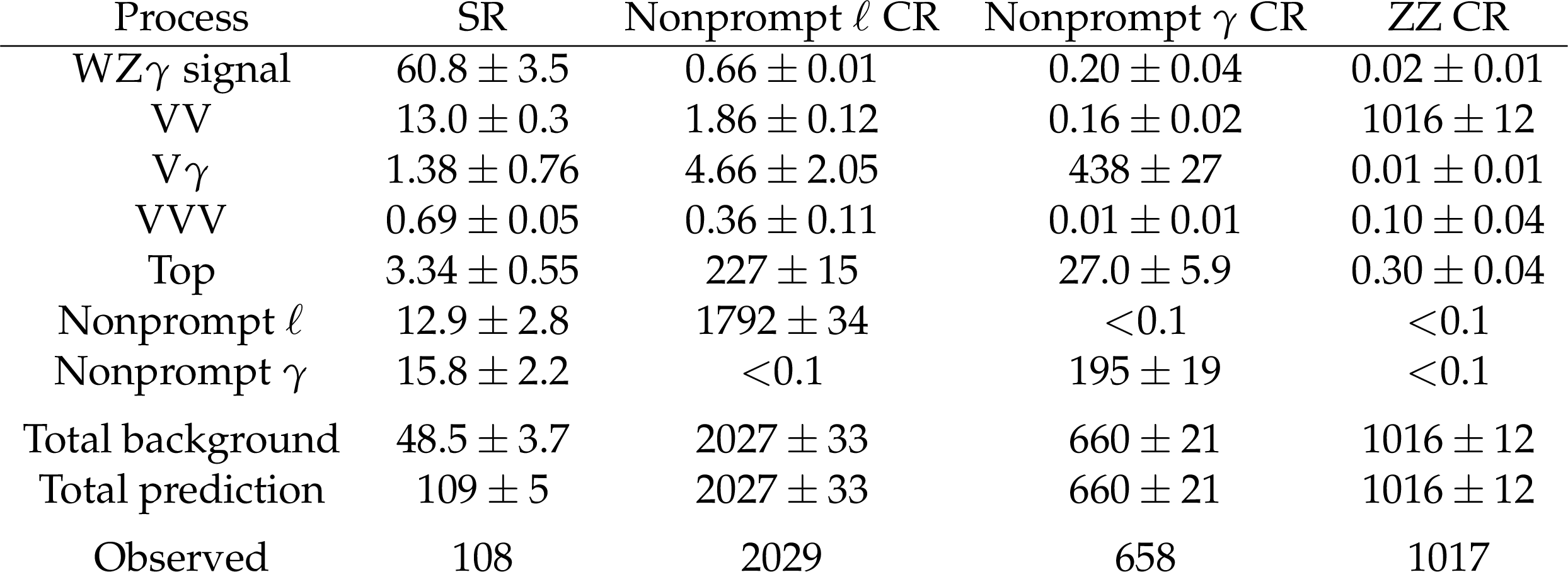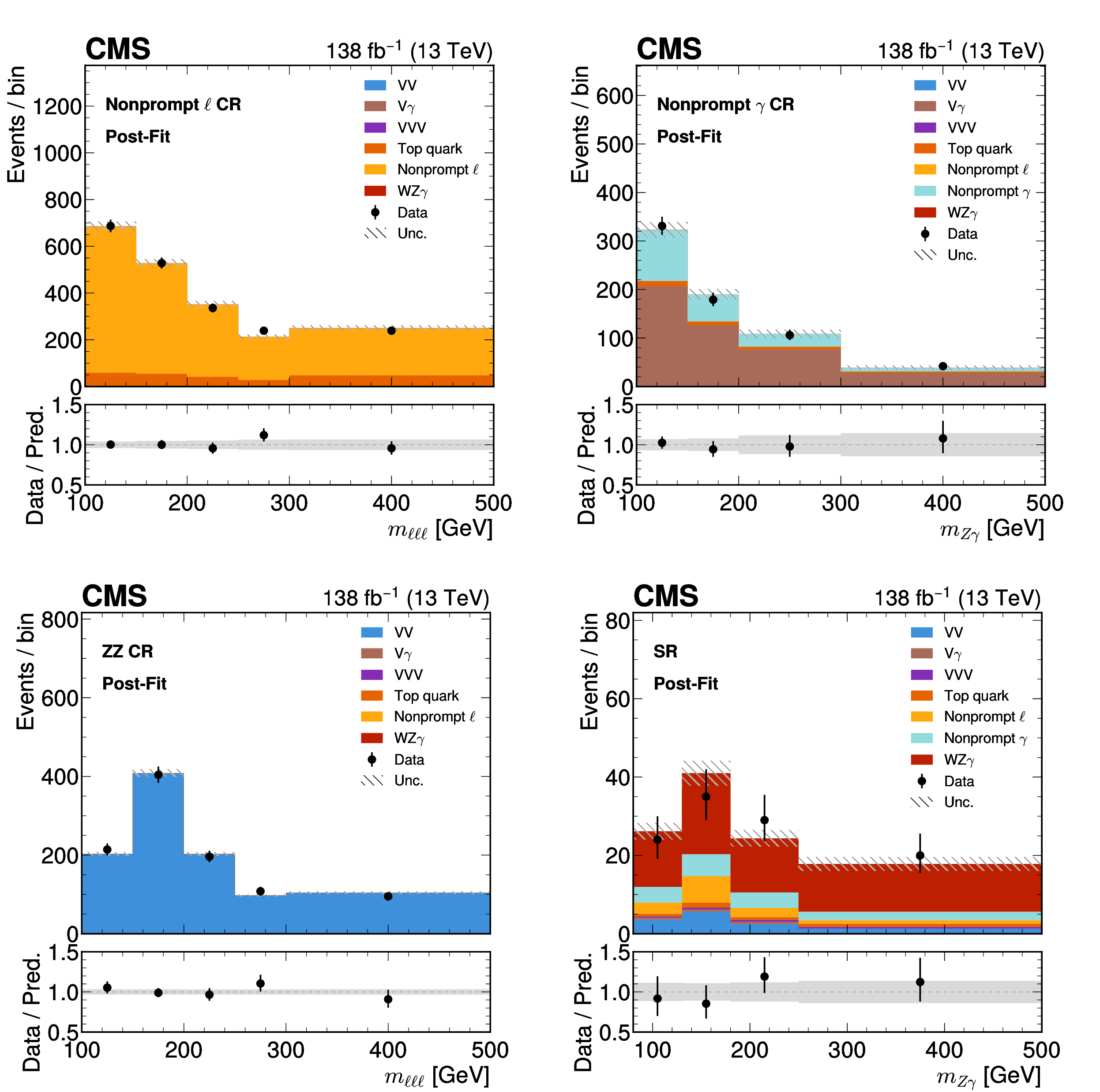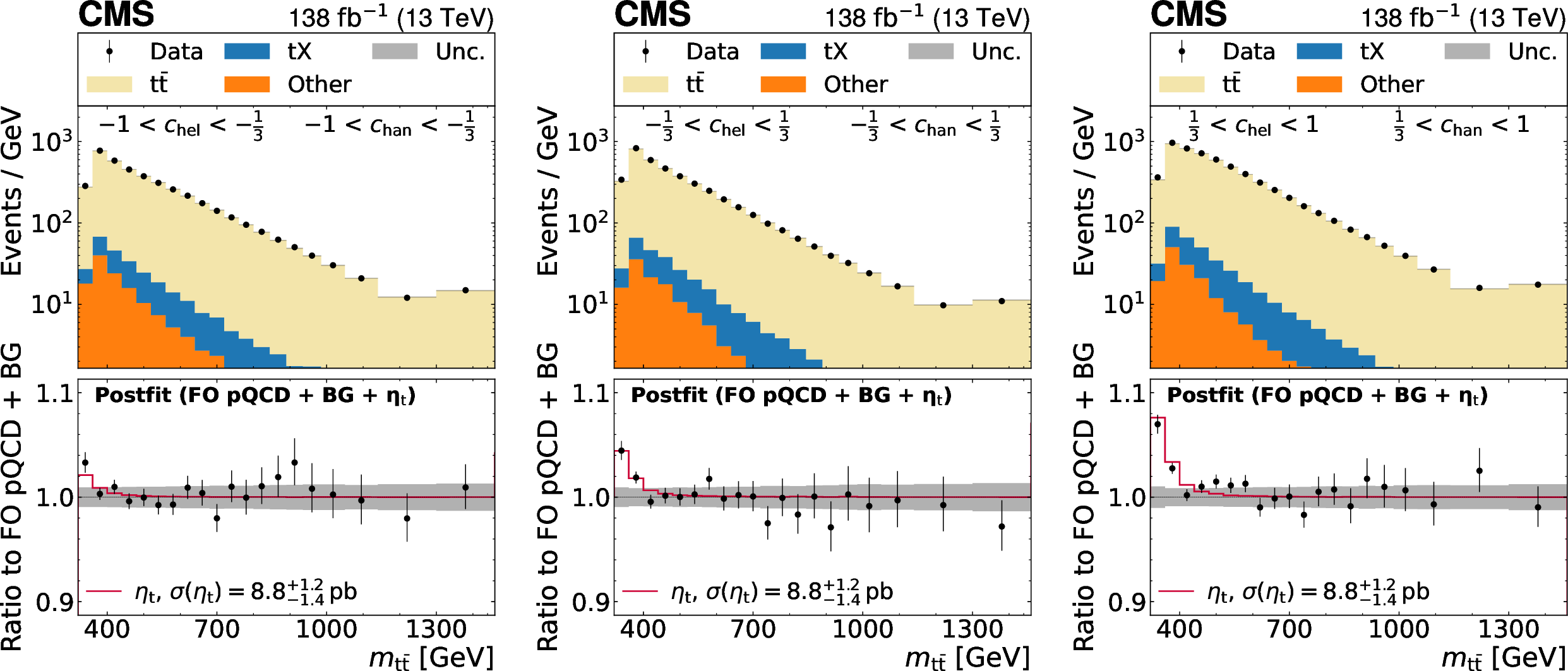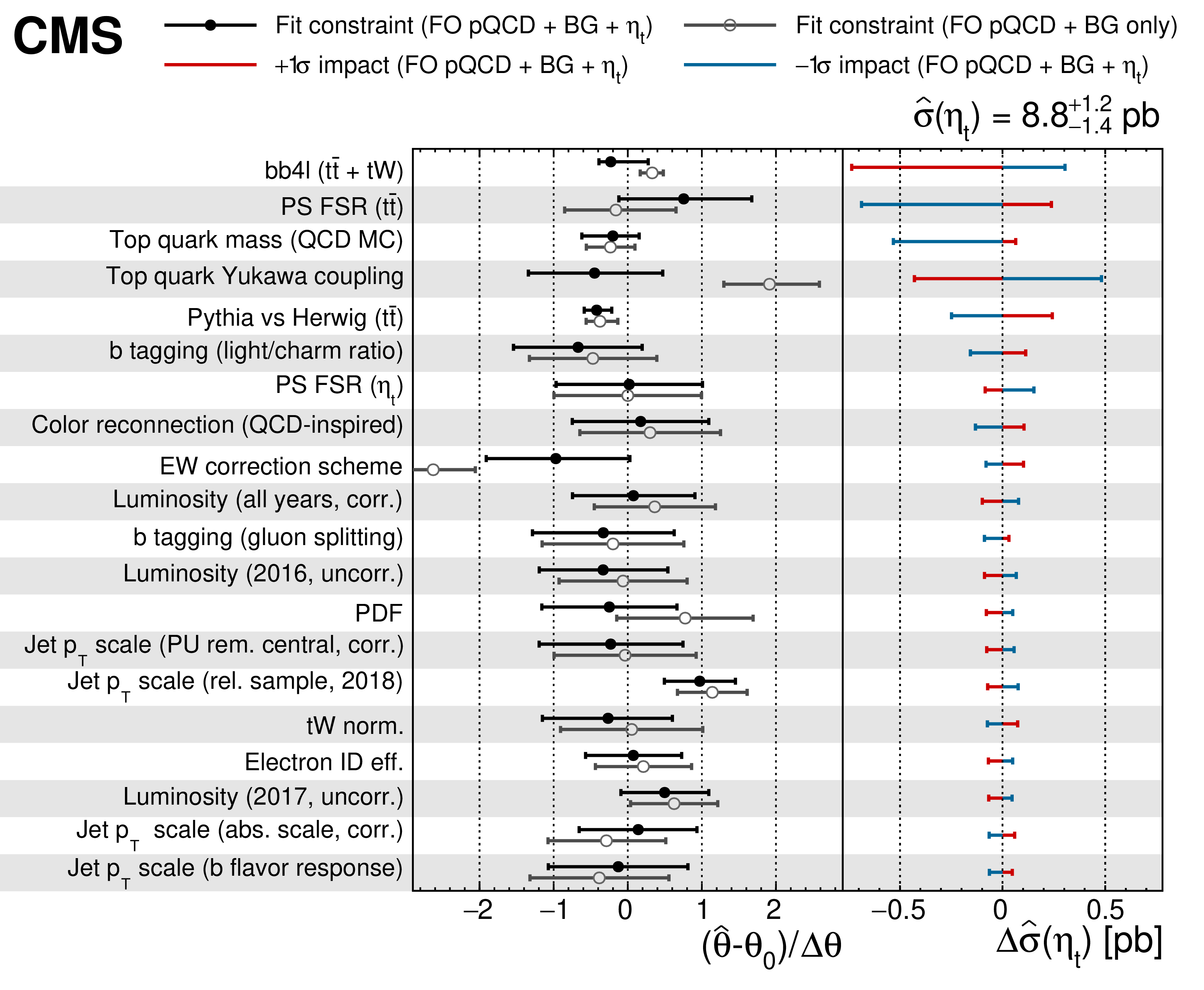Apr 7th, 2025
CMS-SMP-22-018
A measurement of the WZγ triboson production cross section is presented. The analysis is based on a data sample of proton-proton collisions at a center-of-mass energy of √s = 13 TeV recorded with the CMS detector at the LHC, corresponding to an integrated luminosity of 138 fb−1. The analysis focuses on the final state with three charged leptons, ℓ±νℓ+ℓ−, where ℓ = e or μ, accompanied by an additional photon. The observed (expected) significance of the WZγ signal is 5.4 (3.8) standard deviations. The cross section is measured in a fiducial region to be 5.48 ± 1.11 fb, which is compatible with the prediction of 3.69 ± 0.24 fb at next-to-leading order in quantum chromodynamics. Exclusion limits are set on anomalous quartic gauge couplings and on the production cross sections of massive axion-like particles.

CMS-SMP-22-018


CMS-SMP-22-018

CMS-SMP-22-018

CMS-TOP-24-007
A search for resonances in top quark pair (tt) production in final states with two charged leptons and multiple jets is presented, based on proton-proton collision data collected by the CMS experiment at the CERN LHC at √s = 13 TeV, corresponding to 138 fb−1. The analysis explores the invariant mass of the tt system and two angular observables that provide direct access to the correlation of top quark and antiquark spins. A significant excess of events is observed near the kinematic tt threshold compared to the nonresonant production predicted by fixed-order perturbative quantum chromodynamics (pQCD). The observed enhancement is consistent with the production of a color-singlet pseudoscalar (1S[1]0) quasi-bound toponium state, as predicted by nonrelativistic quantum chromodynamics. Using a simplified model for 1S[1]0 toponium, the cross section of the excess above the pQCD prediction is measured to be 8.8+1.2−1.4 pb.
CMS-TOP-24-007

CMS-TOP-24-007

CMS-TOP-24-007

CMS-TOP-24-007


S. Thayil, B. Gomber, et al.
We present the current status of the MATHUSLA (MAssive Timing Hodoscope for Ultra-Stable neutraL pArticles) long-lived particle (LLP) detector at the HL-LHC, covering the design, fabrication and installation at CERN Point 5. MATHUSLA40 is a 40 m-scale detector with an air-filled decay volume that is instrumented with scintillator tracking detectors, to be located near CMS. Its large size, close proximity to the CMS interaction point and about 100 m of rock shielding from LHC backgrounds allows it to detect LLP production rates and lifetimes that are one to two orders of magnitude beyond the ultimate reach of the LHC main detectors. This provides unique sensitivity to many LLP signals that are highly theoretically motivated, due to their connection to the hierarchy problem, the nature of dark matter, and baryogenesis. Data taking is projected to commence with the start of HL-LHC operations. We summarize the new 40m design for the detector that was recently presented in the MATHUSLA Conceptual Design Report, alongside new realistic background and signal simulations that demonstrate high efficiency for the main target LLP signals in a background-free HL-LHC search. We argue that MATHUSLA's uniquely robust expansion of the HL-LHC physics reach is a crucial ingredient in CERN's mission to search for new physics and characterize the Higgs boson with precision.
LHCb Collab.
C. Aidala et al
The LHCb Ntupling Service enables on-demand production and publishing of LHCb Run 2 Open Data and aims at publishing them through the CERN Open Data Portal. It integrates the LHCb Ntuple Wizard to generate the configuration files that link custom user requests to the internal LHCb production system. User requests are managed through a streamlined workflow, from request creation to the final production of ROOT Ntuples, which can be downloaded directly from the Ntupling Service web interface, eliminating the need of running complex experiment-level software on the user side.
F. Arias-Aragón, G. Cortona, E. Nardi, L. Veissière
Due to Heisenbergs uncertainty principle, atomic electrons localized around the nucleus exhibit a characteristic momentum distribution that, in elements with high atomic number, remains significant up to relativistic values. Consequently, in fixed-target experiments, atoms can effectively act as electron accelerators, increasing the centre-of-mass energy in collisions with beam particles. In this work, we leverage this effect to explore its potential for new physics searches. We consider positrons from beams of various energies annihilating with atomic electrons in a 74W fixed target. We compute the production rates of new vector bosons and pseudoscalar particles as functions of their couplings and masses. We show that the electron-at-rest approximation significantly underestimates the mass reach for producing these new states compared to the results obtained by properly accounting for atomic electron momenta. In particular, we estimate the sensitivity for detecting these new particles using the positron beam at the Beam Test Facility linac at the Laboratori Nazionali di Frascati, the H4 beamline in the CERN North Area, and the proposed Continuous Electron Beam Accelerator Facility of Jefferson Laboratory.
G .Piacentino, A. Palladino
The ALPHA collaboration recently published the article "Observation of the effects of gravity on the motion of antimatter" in issue 621 of Nature (2023), in which their conclusion states that "The probability that our data are consistent with repulsive gravity is so small as to be quantitatively meaningless (less than 10−15). Consequently, we can rule out the existence of repulsive gravity of magnitude 1g between the Earth and antimatter." Indeed, their experiment proved that antihydrogen falls toward the Earth. Antihydrogen, however, is a composite particle and its mass, like that of the proton, is dominated by the mass of its binding energy. In this paper, we point out that their experiment only measures the gravitational effect on composite antimatter, and not free or valence antimatter particles such as antiquarks or antileptons. Here, we review the various theoretical frameworks supporting the possibility that valence antiquarks experience a repulsion of the order g by the Earth's gravitational field. We show that the ALPHA collaboration's recent result may actually be consistent with a repulsive gravitational component of about 15%. Next, we review our concept for a direct interaction experiment between antiquarks and the Earths gravitational field, which should be capable of providing irrefutable evidence of the gravitational repulsion of non-composite antiparticles. Finally, we suggest that existing data, collected by AMS-01 of daughter particles from cosmic protons interacting with the Mir space station, may help demonstrate the feasibility of our proposed experiment.